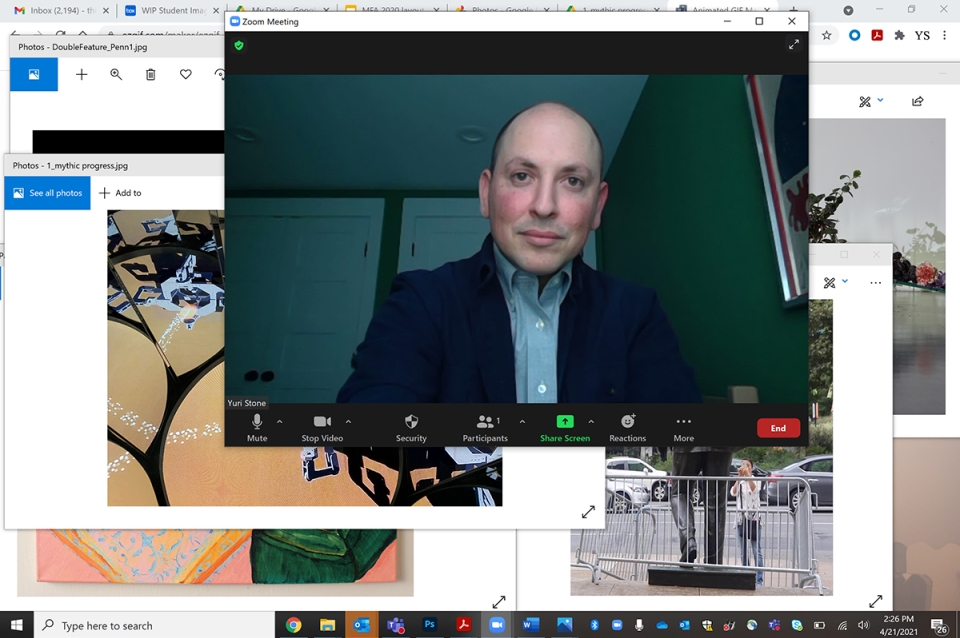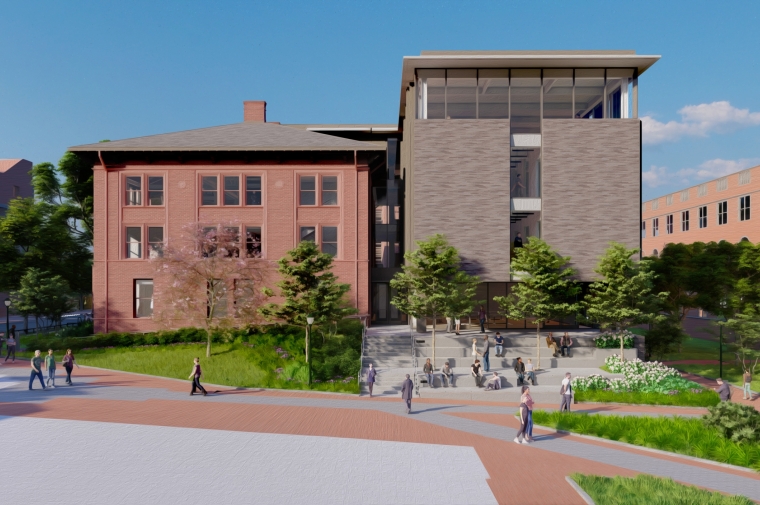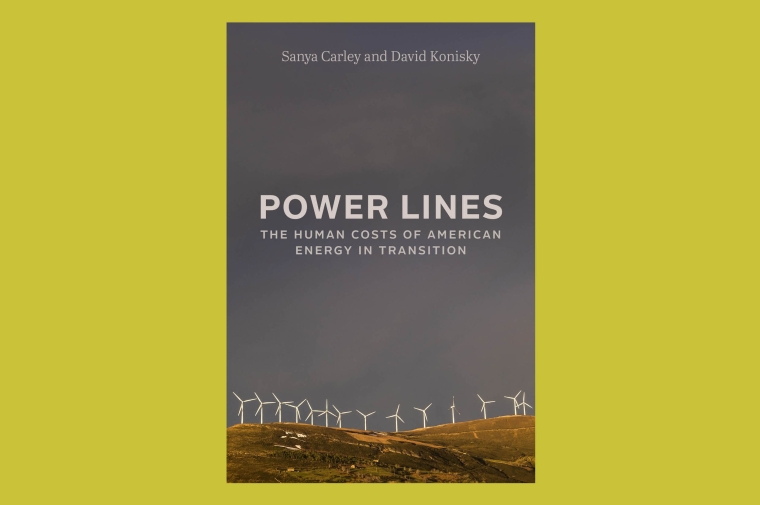April 23, 2021
Stuart Weitzman School of Design
102 Meyerson Hall
210 South 34th Street
Philadelphia, PA 19104
Get the latest Weitzman news in your Inbox
In April and May, the Weitzman School will open the thesis exhibitions for the Class of 2020 and the Class of 2021 in the MFA program in the Department of Fine Arts. The exhibitions will be on view at the Icebox Project Space at the Crane Arts building for members of the Penn community by appointment only (due to COVID-19 safety protocols), from April 25-May 7 for the Class of 2020 and May 14-27 for the Class of 2021. To schedule a visit, Penn faculty, students, and staff should contact mfa@design.upenn.edu.
The exhibitions’ curator is Yuri Stone, assistant curator at the Glenstone Museum, in Potomac, Maryland where he works with artists to realize exhibitions, publications, and long-term outdoor installations. Previously he served as assistant curator at the MIT List Visual Arts Center and program associate at The Renaissance Society, Chicago. Stone was invited to curate these exhibitions by Ken Lum, the Marilyn Jordan Taylor Presidential Professor and chair of fine arts, who recently spoke with Stone via Zoom.
Ken Lum: Hi, Yuri. You arrived at Penn to work with the graduating year MFA students just prior to the pandemic. You were able to meet with the 2nd year class individually and have been working with them since that time virtually. What has it been like for you? How have you adjusted in your role with the students?
Yuri Stone: Yes. I did my first studio visits with the MFA students in the Class of 2020 in Philadelphia in February of 2020. I had no idea it would be the first and last time I’d be in those studios. That experience became an important foundation for continuing the conversation virtually and serves as a reminder of how much you can learn about an artist from just being in their working space.
I’ve also been working with the MFA students in the Class of 2021. Those conversations began in January 2021 and, because they have progressed virtually, are unique in their own way. Working with artists via screen, especially those that work spatially or make work in sculpture, prompts a challenge to reconsider how one articulates what their artwork is and does. And for me, as a curator, I find myself asking different questions than I might if we were in a room together with the artwork. These are new muscles we’re all developing together in real-time; thankfully, all of the artists I’ve met with have been really thoughtful and flexible.
What are the questions that are different from the ones you would have posed had you been able to meet in person? Related to this question, is there a different criteria for curating an exhibition of MFA students? For one thing, you have to include everybody’s work, so the idea of curating someone in or out of an exhibition is not possible.
The questions are what you’d probably expect. I find myself asking more questions around logistics: How is this work hung on the wall? Is it flush to the wall or does it sit slightly off of the wall with a cleat or some other hanging hardware? What is bracing this sculpture to the floor? Is it drilled into your studio floor or is there an internal weight that keeps it balanced? Details that I would be able to see in a space and wouldn’t necessarily have to ask.
Of course, curating an MFA show is a different undertaking than how I’ve gone about organizing exhibitions in the past. Like you said, the artists are determined before I’ve arrived. My goal for both exhibitions, for the MFA 2020 show and the MFA 2021 show, is to meet each artist where they are in their process and to work with each artist to show their strongest work in a balanced and thoughtful exhibition. The other important goal, for me at least, is to have this presentation be productive for everyone involved. For some artists, that means getting proper documentation of work they made a year ago but haven’t had a chance to exhibit; for other artists, it’s a chance to realize work that has been in research and production for the past semester, and for others it’s a chance to reflect on the past year and make new work. I’m not sure if it’s a different criteria for curating an exhibition of MFA students as much as a different set of objectives and variables to consider.
I know it is only one group of students from one particular pedagogical art program, but are you able to take away anything about what it means to be a young, aspiring artist in today’s world?
This experience and the process has given me a small window into what goes into being a young, aspiring artist today—and I’m appreciative of that window—but if there is one thing that is as clear as it has ever been it’s that every artist goes about it a different way. Each artist I’ve met with and worked with has a different vantage of what the world is today and how they see themself as part of it. And maybe as importantly, each artist prioritizes the world around them differently. Some artists look internally and make work in response to their own position, others are consumed by the external and seek to translate their surroundings in their work. Some want to reflect that which they see in the world, others are eager to make things that are unworldly.
Working with this group of students confirms the premise that to be an aspiring artist today is to follow your own instinct. To make work that is of and by you, true to your interests, and what you have prioritized as important. The artists in both MFA exhibitions, amidst and despite the disruption and upheaval that has taken place in the past year, do just that—they make work that is uniquely of themselves and inherently of this (their) time.
What advice would you give to a young artist today who is thinking about an MFA? Or, perhaps, not thinking about an MFA but just thinking about being an artist?
Sure. Of course, when thinking about pursuing an MFA, there’s the financial consideration and calculations that need to be done. And the “uprooting your life” consideration, potentially, too. But if you’re asking if I recommend young artists pursue an MFA, I’d say the right program for the right person can be an incredibly productive and magical experience. It can be very generative both for your work and your thinking. You can meet people and be exposed to things that just aren’t necessarily in your orbit. And there is also something to be said for committing the time and space, mentally and physically, to your practice and getting feedback from peers and faculty, in theory, pushing your work forward.
That being said, MFA or not, if you’re thinking about being an artist, it can be really simple: make things. I’m not an artist so I can’t really speak to the hustle that is part of getting your work out into the world for people to see, but before you get there, you have to make things. Set time aside to make things and make things consistently. In fact, you don’t even have to necessarily “make” things but I find, at least with the artists I’ve worked with in the past, each one builds “studio time,” whatever that might entail—painting, reading, writing, drawing, walking—they build time to make or think about their work into their daily routine. Like anything, the more time you dedicate to your craft, the better you’ll understand it.
Thank you very much, Yuri.


 Expand Image
Expand Image



